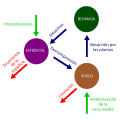File:Nutrient cycle-es.svg

Original file (SVG file, nominally 1,280 × 1,280 pixels, file size: 22 KB)
Captions
Captions
Summary edit
| DescriptionNutrient cycle-es.svg |
Español: Un diagrama del ciclo simplificado de nutrientes.
Los tres principales compartimentos para el almacenamiento de nutrientes:
Las dos entradas (verde claro):
Las dos salidas (rojo):
Los tres fluyen entre los compartimentos (azul):
English: A diagram of the simplified nutrient cycle.
The three main compartments for nutrient store:
The two inputs (light green):
The two outputs (red):
The three flows between the compartments (blue):
|
| Date | |
| Source | Commons - File:Nutrient cycle.svg |
| Author |
|
| Other versions |
[edit]
|
Licensing edit
- You are free:
- to share – to copy, distribute and transmit the work
- to remix – to adapt the work
- Under the following conditions:
- attribution – You must give appropriate credit, provide a link to the license, and indicate if changes were made. You may do so in any reasonable manner, but not in any way that suggests the licensor endorses you or your use.
- share alike – If you remix, transform, or build upon the material, you must distribute your contributions under the same or compatible license as the original.
File history
Click on a date/time to view the file as it appeared at that time.
| Date/Time | Thumbnail | Dimensions | User | Comment | |
|---|---|---|---|---|---|
| current | 08:38, 20 April 2020 |  | 1,280 × 1,280 (22 KB) | Ortisa (talk | contribs) | Uploaded a work by Kayau * de la traducción Ortisa from Commons - https://commons.wikimedia.org/wiki/File:Nutrient_cycle.svg File:Nutrient cycle.svg with UploadWizard |
You cannot overwrite this file.
File usage on Commons
The following 9 pages use this file:
File usage on other wikis
The following other wikis use this file:
- Usage on es.wikipedia.org
Metadata
This file contains additional information such as Exif metadata which may have been added by the digital camera, scanner, or software program used to create or digitize it. If the file has been modified from its original state, some details such as the timestamp may not fully reflect those of the original file. The timestamp is only as accurate as the clock in the camera, and it may be completely wrong.
| Width | 1280 |
|---|---|
| Height | 1280 |








